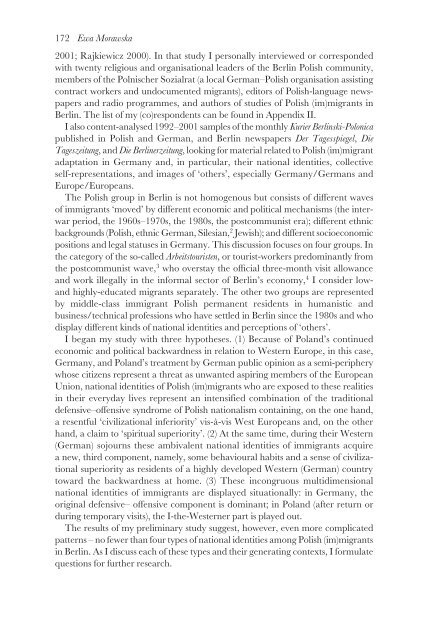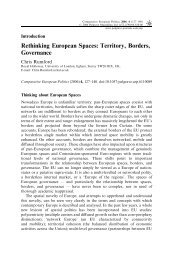Europeanisation, National Identities and Migration ... - europeanization
Europeanisation, National Identities and Migration ... - europeanization
Europeanisation, National Identities and Migration ... - europeanization
You also want an ePaper? Increase the reach of your titles
YUMPU automatically turns print PDFs into web optimized ePapers that Google loves.
172 Ewa Morawska<br />
2001; Rajkiewicz 2000). In that study I personally interviewed or corresponded<br />
with twenty religious <strong>and</strong> organisational leaders of the Berlin Polish community,<br />
members of the Polnischer Sozialrat (a local German–Polish organisation assisting<br />
contract workers <strong>and</strong> undocumented migrants), editors of Polish-language newspapers<br />
<strong>and</strong> radio programmes, <strong>and</strong> authors of studies of Polish (im)migrants in<br />
Berlin. The list of my (co)respondents can be found in Appendix II.<br />
I also content-analysed 1992–2001 samples of the monthly Kurier Berlinski-Polonica<br />
published in Polish <strong>and</strong> German, <strong>and</strong> Berlin newspapers Der Tagesspiegel, Die<br />
Tageszeitung, <strong>and</strong> Die Berlinerzeitung, looking for material related to Polish (im)migrant<br />
adaptation in Germany <strong>and</strong>, in particular, their national identities, collective<br />
self-representations, <strong>and</strong> images of ‘others’, especially Germany/Germans <strong>and</strong><br />
Europe/Europeans.<br />
The Polish group in Berlin is not homogenous but consists of different waves<br />
of immigrants ‘moved’ by different economic <strong>and</strong> political mechanisms (the interwar<br />
period, the 1960s–1970s, the 1980s, the postcommunist era); different ethnic<br />
backgrounds (Polish, ethnic German, Silesian, 2 Jewish); <strong>and</strong> different socioeconomic<br />
positions <strong>and</strong> legal statuses in Germany. This discussion focuses on four groups. In<br />
the category of the so-called Arbeitstouristen, or tourist-workers predominantly from<br />
the postcommunist wave, 3 who overstay the official three-month visit allowance<br />
<strong>and</strong> work illegally in the informal sector of Berlin’s economy, 4 I consider low<strong>and</strong><br />
highly-educated migrants separately. The other two groups are represented<br />
by middle-class immigrant Polish permanent residents in humanistic <strong>and</strong><br />
business/technical professions who have settled in Berlin since the 1980s <strong>and</strong> who<br />
display different kinds of national identities <strong>and</strong> perceptions of ‘others’.<br />
I began my study with three hypotheses. (1) Because of Pol<strong>and</strong>’s continued<br />
economic <strong>and</strong> political backwardness in relation to Western Europe, in this case,<br />
Germany, <strong>and</strong> Pol<strong>and</strong>’s treatment by German public opinion as a semi-periphery<br />
whose citizens represent a threat as unwanted aspiring members of the European<br />
Union, national identities of Polish (im)migrants who are exposed to these realities<br />
in their everyday lives represent an intensified combination of the traditional<br />
defensive–offensive syndrome of Polish nationalism containing, on the one h<strong>and</strong>,<br />
a resentful ‘civilizational inferiority’ vis-à-vis West Europeans <strong>and</strong>, on the other<br />
h<strong>and</strong>, a claim to ‘spiritual superiority’. (2) At the same time, during their Western<br />
(German) sojourns these ambivalent national identities of immigrants acquire<br />
a new, third component, namely, some behavioural habits <strong>and</strong> a sense of civilizational<br />
superiority as residents of a highly developed Western (German) country<br />
toward the backwardness at home. (3) These incongruous multidimensional<br />
national identities of immigrants are displayed situationally: in Germany, the<br />
original defensive– offensive component is dominant; in Pol<strong>and</strong> (after return or<br />
during temporary visits), the I-the-Westerner part is played out.<br />
The results of my preliminary study suggest, however, even more complicated<br />
patterns – no fewer than four types of national identities among Polish (im)migrants<br />
in Berlin. As I discuss each of these types <strong>and</strong> their generating contexts, I formulate<br />
questions for further research.



